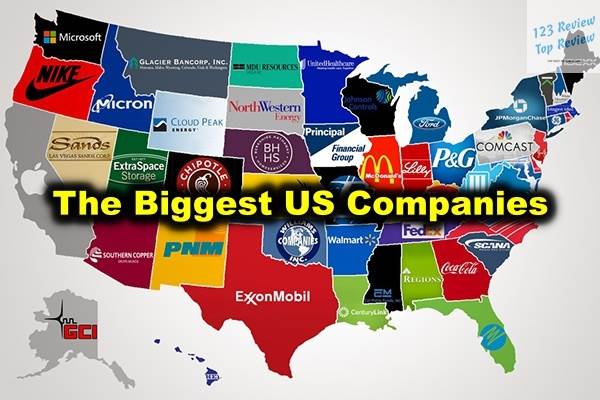In this article, 123 Review provides an overview of these leading corporations, analyzing their rankings, industry impact, workforce dynamics, innovation contributions, global reach, and future outlook.
Company Rankings
Top 10 Biggest Companies by Revenue
The top 10 companies by revenue in the US illustrate the economic might and market influence of these corporate giants. These companies often lead their respective industries, generating billions in revenue annually. For instance, Walmart, the largest retailer in the world, consistently tops the list with revenue exceeding $500 billion. Other major players include Amazon, which has transformed from an online bookstore to a global e-commerce powerhouse, and ExxonMobil, a leader in the energy sector.

Revenue generation is a critical measure of a company’s ability to sustain its operations, invest in growth opportunities, and provide returns to shareholders. Companies like Apple and Berkshire Hathaway also feature prominently on this list, showcasing their diverse business models and significant market influence.
Here are the largest companies by revenue:
- Walmart: $572 billion
- Amazon: $469 billion
- ExxonMobil: $413 billion
- Apple: $365 billion
- Berkshire Hathaway: $354 billion
- UnitedHealth Group: $287 billion
- CVS Health: $268 billion
- McKesson: $264 billion
- AmerisourceBergen: $214 billion
- Alphabet (Google): $182 billion
Top 10 Biggest Companies with the Highest Market Capitalization
Market capitalization, or market cap, is a key indicator of a company’s overall value as perceived by investors. It is calculated by multiplying the current stock price by the total number of outstanding shares. The companies with the highest market caps are often leaders in innovation and technological advancements. For example, Apple, with a market cap surpassing $2 trillion, is a testament to its dominance in the tech industry.
Microsoft and Alphabet (Google’s parent company) also rank highly, reflecting their pivotal roles in the software and internet services sectors, respectively. These companies’ stock performance and market valuations are closely watched indicators of broader market trends and investor confidence.
Here are the largest Companies by Market Capitalization:
- Apple: $2.75 trillion
- Microsoft: $2.40 trillion
- Alphabet (Google): $1.90 trillion
- Amazon: $1.75 trillion
- NVIDIA: $1.10 trillion
- Tesla: $1.00 trillion
- Meta Platforms (Facebook): $0.90 trillion
- Berkshire Hathaway: $0.80 trillion
- UnitedHealth Group: $0.75 trillion
- Johnson & Johnson: $0.65 trillion
Top 10 Fastest Growing Companies in the US
The fastest-growing companies in the US are those experiencing rapid increases in revenue, market share, and profitability. These companies are often at the forefront of emerging industries, driving innovation and capturing significant market opportunities. For example, Tesla has seen explosive growth due to its pioneering role in electric vehicles and renewable energy solutions.
Other notable fast-growing companies include fintech firms like Square and Stripe, which are revolutionizing payment processing and financial services. The growth trajectories of these companies provide valuable insights into future market leaders and potential investment opportunities.
Here are the Fastest Growing Companies:
- Tesla: 70%
- NVIDIA: 65%
- Meta Platforms (Facebook): 60%
- Square: 55%
- Stripe: 50%
- Salesforce: 45%
- ServiceNow: 40%
- Moderna: 35%
- Zoom Video Communications: 30%
- Snowflake: 25%
Comparison of Industry Leaders
Comparing industry leaders involves examining key performance metrics such as revenue, market share, innovation, and profitability. This comparison helps to understand competitive advantages, market positioning, and strategic differences between top companies in various sectors. For instance, in the tech industry, Apple and Microsoft compete closely, with each company leveraging its unique strengths and market strategies.
In the retail sector, Amazon and Walmart represent two different business models – e-commerce and traditional retail – yet both are highly successful. Analyzing these industry leaders offers a deeper understanding of what drives success in different markets and how companies adapt to changing economic conditions.
Industry Analysis
Leading Technology Companies in the US
The US is home to some of the world’s most influential technology companies, including Apple, Microsoft, Google, and Amazon. These companies lead in innovation, research and development, and market share. Apple’s ecosystem of devices and services, Microsoft’s dominance in enterprise software, Google’s leadership in search and advertising, and Amazon’s prowess in e-commerce and cloud computing illustrate the diverse ways these companies shape the tech landscape.
The continuous investment in cutting-edge technologies, such as artificial intelligence, machine learning, and cloud computing, positions these companies at the forefront of global technological advancements. Their products and services not only influence consumer behavior but also drive technological progress worldwide.
Major Retail Companies and Their Impact
Major retail companies like Walmart, Amazon, and Costco have a significant impact on the US economy. Walmart’s extensive brick-and-mortar presence combined with its growing e-commerce platform makes it a retail juggernaut. Amazon’s innovation in logistics and customer service has set new standards for online shopping, while Costco’s membership model has proven highly successful.
These companies influence consumer spending patterns, supply chain logistics, and employment. Their strategies for inventory management, pricing, and customer engagement offer valuable lessons for the retail industry. Analyzing these companies provides insights into retail trends, e-commerce growth, and market dynamics.
Dominant Players in the Energy Sector
The US energy sector includes dominant players such as ExxonMobil, Chevron, and NextEra Energy. These companies are crucial in providing energy resources, advancing sustainable energy solutions, and influencing energy policies. ExxonMobil and Chevron, with their vast oil and gas operations, play key roles in global energy markets, while NextEra Energy is a leader in renewable energy, particularly wind and solar power.
Understanding the operations, strategies, and challenges faced by these companies sheds light on the future of energy in the US. The transition to sustainable energy sources and the impact of regulatory changes are critical factors shaping the industry’s landscape.
Financial Institutions Shaping the Economy
Leading financial institutions like JPMorgan Chase, Bank of America, and Goldman Sachs play a pivotal role in shaping the US economy. They provide essential financial services, drive investment activities, and influence economic policies. JPMorgan Chase’s comprehensive banking services, Bank of America’s consumer banking and wealth management, and Goldman Sachs’ investment banking and asset management highlight their diverse contributions.
Analyzing these institutions helps to understand their impact on financial stability, economic growth, and the broader financial ecosystem. Their strategies for risk management, innovation in financial products, and responses to regulatory changes are critical for understanding their roles in the economy.
Employment and Workforce
Companies with the Largest Workforce
Companies with the largest workforce, such as Walmart, Amazon, and Kroger, are significant employers in the US. Walmart, with over 2 million employees worldwide, is the largest private employer globally. Amazon’s rapid expansion has also led to substantial job creation, particularly in its fulfillment centers.
Their employment practices, wage policies, and workforce management strategies have broad implications for the labor market and economic stability. These companies’ approaches to employee training, benefits, and workplace safety are critical for maintaining a productive and satisfied workforce.
Top Employers by Industry
Identifying top employers by industry helps to understand the employment landscape in sectors such as technology, healthcare, retail, and manufacturing. In the tech industry, companies like Google, Facebook, and Microsoft are known for their innovative work environments and competitive compensation packages. In healthcare, organizations like HCA Healthcare and CVS Health employ large numbers of healthcare professionals and support staff.
These employers are often leaders in their fields and set standards for employment practices, benefits, and workplace culture. Their contributions to job creation and economic growth are significant, providing valuable insights into industry-specific employment trends.
Employees’ Satisfaction Levels at Major Firms
Employee satisfaction levels at major firms are critical for understanding workplace culture, productivity, and retention rates. Surveys and studies on employee satisfaction provide insights into how companies manage their human resources and foster a positive work environment. Companies like Google and Salesforce are often highlighted for their employee-friendly policies and strong organizational cultures.
High levels of employee satisfaction are linked to increased productivity, lower turnover rates, and better overall company performance. Understanding the factors that contribute to employee satisfaction helps companies create better work environments and attract top talent.
Trends in Employee Retention
Trends in employee retention reveal how companies are adapting to changing workforce expectations and maintaining a stable workforce. Factors such as career development opportunities, company culture, and benefits packages play a significant role in retention strategies. Companies that invest in employee development, provide clear career progression paths, and foster inclusive cultures tend to have higher retention rates.
The shift towards remote work and flexible working arrangements has also influenced retention trends, with companies adapting to new ways of working to retain their employees. Analyzing these trends provides insights into how companies can improve employee loyalty and reduce turnover.
Innovation and Research
Companies Investing Most in R&D
Companies investing heavily in research and development (R&D) are often at the forefront of innovation. Tech giants like Google, Apple, and Microsoft allocate significant resources to R&D to develop new products, services, and technologies that drive their competitive advantage. These investments lead to breakthroughs in areas such as artificial intelligence, machine learning, and healthcare technologies.
Pharmaceutical companies like Pfizer and Johnson & Johnson also invest heavily in R&D, leading to the development of new drugs and medical treatments. Understanding the R&D strategies of these companies provides insights into future technological advancements and market opportunities.
Impact of Technology on Business Growth
The impact of technology on business growth is profound, enabling companies to streamline operations, enhance customer experiences, and explore new business models. Technologies such as cloud computing, big data analytics, and the Internet of Things (IoT) are transforming how businesses operate and compete.
Companies that effectively leverage technology to innovate, improve efficiency, and provide superior customer value are likely to achieve significant growth. Analyzing how leading companies use technology provides valuable insights into future business trends and opportunities.
Contributions to Sustainability and Green Tech
Leading US companies are increasingly focusing on sustainability and green technology. Companies like Tesla, General Electric, and NextEra Energy are investing in renewable energy, reducing carbon footprints, and developing sustainable products. Tesla’s electric vehicles and solar products, General Electric’s wind turbines, and NextEra Energy’s solar and wind farms are examples of their contributions to a sustainable future.
These efforts contribute to environmental conservation and set industry standards. Understanding how companies integrate sustainability into their business models provides insights into the future of green technology and corporate responsibility.
Patents and Innovations from Leading Corporations
Patents and innovations from leading corporations highlight their commitment to intellectual property and technological advancement. Companies like IBM, Intel, and Qualcomm are prolific in securing patents, driving innovation, and maintaining competitive edges in their respective industries.
These patents often lead to new products, services, and business models that shape the market landscape. Analyzing patent trends and innovations provides insights into the future direction of technological advancements and the competitive dynamics of various industries.
Global Reach
US Companies with the Largest International Presence
US companies with the largest international presence, such as Coca-Cola, McDonald’s, and Procter & Gamble, have extensive global operations. Their strategies for market penetration, localization, and brand recognition are critical for understanding their global influence and success. Coca-Cola’s vast distribution network, McDonald’s localization of menu items, and Procter & Gamble’s global branding efforts exemplify their international strategies.
These companies’ ability to navigate different cultural, regulatory, and market environments is crucial for their global success. Analyzing their international operations provides insights into effective global business strategies.
Impact of Foreign Markets on Growth
The impact of foreign markets on growth is significant for US companies looking to expand their reach. Foreign markets offer new revenue streams, diversification opportunities, and growth potential. Companies like Apple generate a substantial portion of their revenue from international markets, particularly in regions like China and Europe.
Analyzing how companies navigate international markets, adapt to local regulations, and cater to diverse consumer preferences provides insights into their global growth strategies. Understanding the challenges and opportunities in foreign markets is essential for assessing the future growth potential of US companies.
Strategies for Global Expansion
Strategies for global expansion involve market entry tactics, partnership formations, and localization efforts. Leading US companies often employ strategic mergers and acquisitions, joint ventures, and tailored marketing approaches to succeed in international markets. For example, Starbucks’ partnership with local firms in China and its localization of product offerings have contributed to its success in the region.
These strategies are designed to mitigate risks, maximize market opportunities, and ensure sustainable growth. Analyzing successful global expansion strategies provides valuable lessons for other companies looking to enter international markets.
Challenges Faced by US Companies Overseas
US companies face various challenges overseas, including regulatory hurdles, cultural differences, and competitive pressures. Navigating different regulatory environments, understanding local consumer behavior, and competing with established local firms are some of the common challenges.
Understanding these challenges helps to appreciate the complexities of global business operations and the strategies companies employ to overcome them. Companies that successfully navigate these challenges can achieve significant growth and establish strong international presences.
Future Outlook
Upcoming Trends Among US Corporations
Upcoming trends among US corporations include increased focus on digital transformation, sustainability, and remote work. Companies are adapting to changing market conditions and consumer behaviors by leveraging technology and innovation. Digital transformation initiatives are reshaping business models, enhancing operational efficiency, and improving customer experiences.
Sustainability is becoming a core business priority, with companies investing in renewable energy, reducing waste, and promoting social responsibility. The shift towards remote work and flexible working arrangements is also influencing corporate strategies and workplace dynamics.
Predictions for the Growth of Major Industries
Predictions for the growth of major industries such as technology, healthcare, and renewable energy highlight potential areas of economic expansion. The technology sector is expected to continue its rapid growth, driven by advancements in artificial intelligence, cybersecurity, and digital transformation.
Healthcare is poised for significant growth due to aging populations, technological innovations in medical treatments, and increased focus on preventive care. Renewable energy is set to expand as companies and governments invest in sustainable energy solutions to combat climate change.
Analyzing industry forecasts helps to identify future market leaders and investment opportunities. Understanding the factors driving growth in these industries provides insights into the future direction of the US economy.
Influence of Technology on Future Operations
The influence of technology on future operations is expected to grow, with advancements in artificial intelligence, automation, and data analytics driving efficiency and innovation. Companies investing in these technologies are likely to gain a competitive edge by streamlining operations, improving decision-making, and enhancing customer experiences.
The integration of advanced technologies into business processes is transforming how companies operate and compete. Analyzing the impact of technology on future operations provides valuable insights into the future of business and the competitive landscape.
Corporate Responsibility and Ethical Considerations
Corporate responsibility and ethical considerations are increasingly important for US companies. Companies are focusing on environmental sustainability, social equity, and transparent governance to meet stakeholder expectations and build long-term trust. Initiatives such as reducing carbon emissions, promoting diversity and inclusion, and ensuring ethical business practices are becoming integral to corporate strategies.
Understanding the importance of corporate responsibility and ethical considerations helps to assess the long-term sustainability and reputation of companies. Companies that prioritize these values are likely to achieve greater customer loyalty, employee satisfaction, and overall success.
In conclusion, the biggest US companies are diverse and influential, shaping the economy, driving innovation, and setting industry standards. By analyzing their rankings, industry impact, workforce dynamics, innovation contributions, global reach, and future outlook, we gain a comprehensive understanding of their roles in the global market and their potential for future growth.





